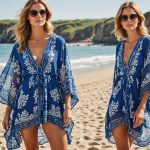Choosing the Right Fabrics for Stylish Face Masks
Selecting the right fabrics for your DIY face masks is crucial for both style and functionality. Ideal fabrics should be tightly-woven cotton or linen, as these provide durability and breathability while being comfortable against the skin. Unlike synthetic materials, natural fibers better filter respiratory droplets.
When coordinating face masks with your wardrobe, consider patterns and colors. Neutral tones like beige, black, and grey are versatile, seamlessly blending with most outfits. Meanwhile, vibrant patterns can add a pop of color, turning your mask into a stylish accessory. Choosing patterns that mirror clothing prints can improve coordination.
Also read : Discover Top UK Sustainable Brands for Luxurious Winter Coats: Unveil Your Perfect Outerwear!
Sustainable fabric choices, like organic cotton or recycled materials, are eco-friendly options. These help reduce environmental impact while offering excellent performance. Using remnants or upcycled textiles from unworn clothing or household linens not only conserves resources but also adds a personal touch to your face masks.
For those keen on experimenting, mixing different textures or layered fabrics can create a unique look, ensuring that your face mask complements your personal style while fulfilling its protective function. Stay comfortable and stylish by selecting high-quality materials that align with your aesthetic preferences.
Also read : Transform your nighttime look: innovative styling tips for dazzling metallic accents
Ensuring Comfort and Fit in Your Masks
Finding the perfect mask fitting seamlessly balances comfort and effectiveness. A proper fit is essential, not only for protection but also for comfort during daily wear. Adjustment techniques play a crucial role; simple solutions such as adjustable ear loops can accommodate different face shapes and sizes. Elastic bands should be snug yet gentle to avoid discomfort or irritation.
For a comfortable fit, consider using comfort materials on areas in contact with your skin. Soft fabrics like cotton or bamboo can enhance this experience by minimizing friction. Selecting a breathable lining will help regulate warmth and moisture, making your mask more pleasant to wear throughout the day.
Snug adjustment around the nose and chin areas improves the mask’s overall performance. Mouldable nose wires can help customize the fit, preventing the mask from slipping and optimizing its protective efficacy. Additionally, learning how to adjust your mask for varying conditions ensures a consistently comfortable fit, whether you’re indoors or braving the elements outside.
These simple steps and thoughtful fabric choices will contribute to a more comfortable and effective wearing experience, allowing you to focus more on your day and less on discomfort or readjusting your mask.
DIY Face Mask Making Tips
Discovering the art of crafting DIY face masks can be both a practical and creative endeavour. To start, having a clear face mask tutorial is essential. These guides usually begin with size which ensures a good fit. Essential sewing tips can include pinning fabric securely to prevent shifting and using zigzag stitches for stretchable areas.
Step-by-Step Guide to Sewing Your Own Face Mask
To sew your own face mask, begin by cutting two fabric pieces, each around 9 by 7 inches, for adults. Place them with right sides facing each other, and sew along the longer edge. Leave a small gap for turning. Once flipped inside out, press flat. Create pleats to allow for comfort while wearing, and sew the sides, inserting elastic before stitching to secure fit.
Customization Ideas for Personal Style
Add flair to your masks by choosing your favourite patterns or embroidered initials. For increased protection, consider a pocket for inserting filters. Such customization allows for experimenting with textures and lace accents, personalizing your mask to reflect your unique style.
Essential Tools and Materials Needed
Gathering the right tools, such as a reliable sewing machine and sharp scissors, streamlines the process. Choose durable materials like cotton and elastic, including other essentials like pins and threads. With a bit of practice, these tools create functional and fashionable masks.
Choosing the Right Fabrics for Stylish Face Masks
Embarking on the journey of crafting DIY face masks involves meticulous fabric selection, crucial for achieving both style and functionality. When selecting fabrics, opt for tightly-woven cotton or linen. These fabrics offer advantages over synthetic options due to their breathability and effectiveness in filtering respiratory droplets. The durability of natural fibers ensures that your masks remain comfortable for repeated use.
Harmonizing Patterns and Colors with Your Wardrobe
When thinking about wardrobe coordination, consider patterns and colors that complement your clothing. Neutral tones like beige, black, and grey offer versatility, enabling easy integration with various outfits. Meanwhile, bold patterns can turn your face mask into a fashionable accessory, allowing you to express your unique style through matching or contrasting designs.
Sustainable Choices for Eco-Friendly Mask Making
Incorporate sustainable fabric choices into your mask-making process, selecting organic cotton or recycled materials. These choices not only minimise environmental impact but also enhance breathability and performance. Utilising remnants or repurposed textiles adds a personal touch while reducing waste. This approach promotes eco-friendliness without sacrificing the quality or style of your DIY face masks.
Seasonal Trends in UK Scarf Fashion
Staying up-to-date with winter trends in the UK can have a significant impact on your scarf choices and overall wardrobe dynamics. This season, scarf styles are leaning towards oversized designs and luxurious materials like cashmere and merino wool, which not only offer warmth but also a touch of elegance. Look out for pieces that feature bold patterns or subtle colours, crafted to align with contemporary UK fashion aesthetics.
Influential Designers and Brands
Notable designers such as Burberry and Alexander McQueen are steering UK fashion with their innovative scarf designs, incorporating iconic patterns and modern twists. These brands highlight both traditional and avant-garde approaches, from classic check prints to contemporary digital prints. Such options provide versatility in styling, catering to various taste preferences.
Practical Tips for Finding Trendy Scarves
To find the perfect scarf that embodies these winter trends, consider local boutiques or sustainable brands focused on eco-friendly production. Scarves that integrate sustainable practices add value beyond style, promoting a conscientious fashion choice. Always examine the material and craftsmanship, ensuring that the scarf offers both durability and the desired aesthetic appeal. This ensures your winter accessory is both practical and stylish.
The Importance of Scarves in Winter Fashion
Scarves are essential fashion accessories that seamlessly blend utility and style, playing a pivotal role in completing winter outfits. As temperatures drop, the significance of scarves in warding off the chill becomes evident. However, beyond their functional purpose, scarves are central to enhancing one’s winter style.
Trending styles this season include oversized and textured options, which not only provide warmth but also make a strong sartorial statement. Luxurious materials such as cashmere and merino wool are particularly favoured for their softness and insulation properties. These rich textures impart a touch of elegance, transforming even the simplest of outfits into something sophisticated.
In terms of colour, subtle tones like navy and charcoal maintain popularity for their versatility, yet bold hues and patterns are making waves, allowing wearers to express individuality and add flair to their ensembles. The versatility of scarves enables them to serve as focal points or seamlessly blend with attire, illustrating their adaptability within diverse fashion contexts.
Thus, investing in scarves that align with current trends not only elevates your aesthetic but also ensures that you remain fashionably snug throughout the colder months.
Types of Scarves for Every Occasion
Scarves are one of the most versatile fashion accessories in any wardrobe, suitable for various occasions and styles. From classic wraps to modern infinity styles, each offers unique advantages in both warmth and styling versatility.
Different Styles of Scarves: From Wraps to Infinity
Traditional wraps are popular for their elegance and adaptability. Infinity scarves, with their continuous loop, offer simplicity and a chic appearance. They’re perfect for casual outings. Alternatively, square scarves can be tied in diverse ways, providing a fresh look each time.
Fabric Choices for Warmth and Style
Selecting the right materials is vital for both warmth and aesthetic appeal. Wool and cashmere are favoured for their insulating properties, keeping you snug in colder months. For lightweight versatility, cotton and silk blend seamlessly with spring and autumn outfits. Each fabric provides a different texture and styling versatility, enabling you to tailor looks to any season or occasion.
Versatile Ways to Wear a Scarf
Drape a scarf loosely for a relaxed flair, or try the belted wrap style for a sophisticated touch. Experimentation is key, allowing you to explore diverse looks. This versatility ensures a scarf can enhance any outfit, serving as a practical and stylish accessory.








